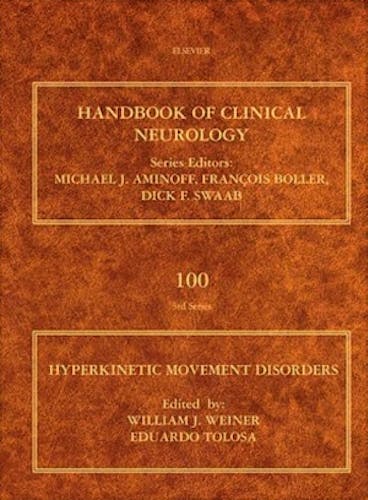

No hay productos en el carrito



Handbook of Clinical Neurology, Vol. 100: Hyperkinetic Movement Disorders
Weiner, W. — Tolosa, E.
1ª Edición Septiembre 2011
Inglés
Tapa blanda
768 pags
1500 gr
null x null x null cm
ISBN 9780444520142
Editorial ELSEVIER
DESCRIPTION
A volume in the Handbook of Clinical Neurology series on hyperkinetic movement disorders.
KEY FEATURES
- A volume in the Handbook of Clinical Neurology series, which has an unparalleled reputation as the world's most comprehensive source of information in neurology.
- International list of contributors including the leading workers in the field.
- Describes the advances which have occurred in clinical neurology and the neurosciences, their impact on the understanding of neurological disorders and on patient care.
TABLE OF CONTENTS
- SECTION 1 - Choreoathetoid Diseases and Syndromes:
- 1. Huntington's disease - clinical signs, symptoms, pre-symptomatic diagnosis and diagnosis
- 2. Huntington's disease
- 3. Molecular biology of Huntington's disease
- 4. Huntington's disease - neuropathology
- 5. Huntington's disease - look-alikes
- 6. Spinocerebellar degenerations
- 7. Neuroacanthocytosis
- 8. Dentatorubral pallidoluysian atrophy
- 9. Neurodegeneration with brain iron accumulation
- 10. Movement disorders and mitochondrial disease
- 11. Acquired hepatocerebral degeneration
- 12. Benign hereditary chorea
- 13. Senile chorea
- SECTION 2 - Immune Related Chorea:
- 14. Sydenham's chorea
- 15. Chorea gravidarum
- 16. Antiphospholipid sydrome and other lupus related movement disorders
- SECTION 3 - Vascular Related Chorea:
- 17. Hemiballismus
- 18. Vascular chorea in adults and children
- 19. Polycythemia and chorea
- SECTION 4 - Metabolic Disturbances:
- 20. Hyperthyroid chorea
- 21. Hyperglycemic non-ketotic states and other metabolic imbalances
- SECTION 5 - Chorea in Other Medical Settings:
- 22. Postoperative encephalopathy with choreoathetosis
- 23. Movement disorders in patients with multiple sclerosis
- 24. Paraneoplastic syndromes causing movement disorders
- 25. Hyperkinetic movement disorders associated with HIV and other viral infections
- 26. Chorea caused by toxins
- 27. Drug-induced hyperkinetic movement disorders by non-neuroleptic agents
- SECTION 6 - Other Syndromes:
- 28. Paroxysmal choreodystonic disorders
- 29. Painful legs and moving toes
- SECTION 7 - Athetosis:
- 30. Birth-related syndromes of athetosis and kernicterus
- SECTION 8 - Myoclonus:
- 31. Myoclonus
- 32. Startle syndromes
- SECTION 9 - Essential Tremor:
- 33. Essential tremor
- 34. Management of essential tremor including medical and surgical approaches
- 35. Orthostatic tremor - a review
- SECTION 10 - Dystonia:
- 36. Early-onset primary dystonia
- 37. Adult-onset dystonia
- 38. Non-primary dystonias
- 39. Dopa responsive dystonia
- 40. Rapid-onset dystonia-Parkinsonism
- 41. Myoclonus dystonia syndrome
- SECTION 11 - Tardive Dyskinesia:
- 42. Typical and atypical neuroleptics
- 43. Epidemiology of tardive dyskinesia before and during the era of modern antipsychotic drugs
- 44. Unusual focal dyskinesias
- SECTION 12 - Tics:
- 45. Stereotypic movement disorders
- 46. Tourette syndrome and other tic disorders
- SECTION 13 - Other Syndromes:
- 47. Restless legs syndrome
- 48. Hemifacial spasm
- 49. Wilson's disease
- 50. Task-specific tremor
- 51. Hyperkinetic psychogenic movement disorder
AUTHOR
ByEdited by William J. Weiner, MD, Professor and Chairman, Department of Neurology, University of Maryland School of Medicine; Director, Maryland Parkinson's Diseases and Movement Disorders Centre, Baltimore, MD, USA and Eduardo Tolosa, MD, Chief of Neurology Service, Hospital Clinic, University of Barcelona, Spain
© 2025 Axón Librería S.L.
2.149.0